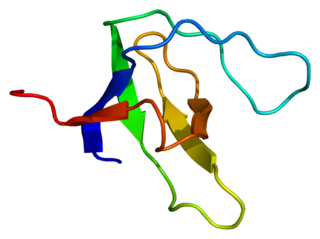
Nephrin is a protein necessary for the proper functioning of the renal filtration barrier. The renal filtration barrier consists of fenestrated endothelial cells, the glomerular basement membrane, and the podocytes of epithelial cells. Nephrin is a transmembrane protein that is a structural component of the slit diaphragm. They are present on the tips of the podocytes as an intricate mesh and convey strong negative charges which repel protein from crossing into the Bowman's space.

Zonula occludens-1 ZO-1, also known as Tight junction protein-1 is a 220-kD peripheral membrane protein that is encoded by the TJP1 gene in humans. It belongs to the family of zonula occludens proteins, which are tight junction-associated proteins and of which, ZO-1 is the first to be cloned. It was first isolated in 1986 by Stevenson and Goodenough using a monoclonal antibody raised in rodent liver to recognise a 225-kD polypeptide in whole liver homogenates and in tight junction-enriched membrane fractions. It has a role as a scaffold protein which cross-links and anchors Tight Junction (TJ) strand proteins, which are fibril-like structures within the lipid bilayer, to the actin cytoskeleton.

Peripheral plasma membrane protein CASK is a protein that in humans is encoded by the CASK gene. This gene is also known by several other names: CMG 2, calcium/calmodulin-dependent serine protein kinase 3 and membrane-associated guanylate kinase 2. CASK gene mutations are the cause of XL-ID with our without nystagmus and MICPCH, an X-linked neurological disorder.

Podocin is a protein that in humans is encoded by the NPHS2 gene.

Polycystin-2 is a protein that in humans is encoded by the PKD2 gene.

Na(+)/H(+) exchange regulatory cofactor NHE-RF3 is a protein that in humans is encoded by the PDZK1 gene.

Nephrocystin-1 is a protein that in humans is encoded by the NPHP1 gene.

Lysine N-methyltransferase 2C (KMT2C) also known as myeloid/lymphoid or mixed-lineage leukemia protein 3 (MLL3) is an enzyme that in humans is encoded by the KMT2C gene.

Sodium channel subunit beta-3 is a protein that in humans is encoded by the SCN3B gene. Two alternatively spliced variants, encoding the same protein, have been identified.

Annexin A8-like protein 2 is a protein that in humans is encoded by the ANXA8L2 gene.

B-cell lymphoma/leukemia 11A is a protein that in humans is encoded by the BCL11A gene.

DnaJ homolog subfamily A member 2 is a protein that in humans is encoded by the DNAJA2 gene.

60S ribosomal protein L13 is a protein that in humans is encoded by the RPL13 gene.

Plexin-A2 is a protein that in humans is coded by the PLXNA2 gene.

Kin of IRRE-like protein 1, also known as NEPH1, is a protein that in humans is encoded by the KIRREL gene.

Transmembrane protein 43 is a protein that in humans is encoded by the TMEM43 gene. TMEM43 may have an important role in maintaining nuclear envelope structure by organizing protein complexes at the inner nuclear membrane. Required for retaining emerin at the inner nuclear membrane. However, the localization of TMEM43 in myocardial tissue is controversial discussed. Franke et al. demonstrated that TMEM43 is localized at the intercalated disc but not at the nuclear envelope. In contrast Christensen et al. have shown that TMEM43 is mainly localized at the sarcolemma. Mutations in TMEM43 are associated with ARVD and EDMD7.

Zinc finger protein 34 is a protein that in humans is encoded by the ZNF34 gene.

Kin of IRRE-like protein 2, also known as NEPH3, is a protein that in humans is encoded by the KIRREL2 gene. It is primarily expressed in β cells of the pancreatic islets.

Extracellular matrix protein FRAS1 is a protein that in humans is encoded by the FRAS1 gene. This gene encodes an extracellular matrix protein that appears to function in the regulation of epidermal-basement membrane adhesion and organogenesis during development.

Transmembrane protein 117 is a protein that in humans is encoded by the TMEM117 gene.




















